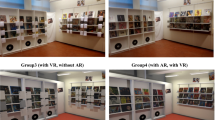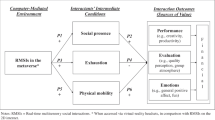Abstract
We present a framework for the analysis and evaluation oftravel, or viewpoint motion control, techniques for use in immersive virtual environments (VEs). In previous work, we presented a taxonomy of travel techniques and a set of experiments mapping parts of the taxonomy to various performance metrics. Since these initial experiments, we have expanded the framework to allow evaluation of not only the effects of different travel techniques, but also the effects of many outside factors simultaneously. Combining this expanded framework with the measurement of multiple response variables epitomises the philosophy oftestbed evaluation. This experimental philosophy leads to a deeper understanding of the interaction and the technique(s) in question, as well as to broadly generalisable results. We also present an example experiment within this expanded framework, which evaluates the user's ability to gather information while travelling through a virtual environment. Results indicate that, of the variables tested, the complexity of the environment is by far the most important factor.
Similar content being viewed by others
References
Herndon K, van Dam A, Gleicher M. The challenges of 3D interaction. SIGCHI Bulletin 1994; 26(4): 36–43
Schieser E. Principles of navigation. In: Handbook of modern electronics and electrical engineering. Belove C. ed. Chichester: Wiley 1986
Warren R, Wertheim A. (eds.) Perception and control of self-motion. Erlbaum. Hillsdale, NJ 1990
Wickens C, Baker P. Cognitive issues in virtual reality. In: Virtual environments and advanced interface design Barfield W, Furness T, eds. Oxford: Oxford University Press 1995
Darken R, Sibert J. A toolset for navigation in virtual environments. Proceedings of the Symposium on User Interface Software and Technology 1993; 157–165
Darken R, Sibert J. Navigating in large virtual worlds. International Journal of Human-Computer Interaction 1996; 8(1): 49–72
Darken R, Sibert J. Wayfinding strategies and behaviors in large virtual worlds. Proceedings of CHI 1996; 142–149
Ingram R Benford S. Legibility enhancement for information visualization. Proceedings of Visualization 1995; 209–216
Lynch, K. The image of the city. MIT Press, Cambridge, MA 1960
Ware C, Jessome D. Using the bat: A six-dimensional mouse for object placement. IEEE Computer Graphics and Applications 1988; 8(6): 65–70
Ware C, Osborne S. Exploration and virtual camera control in virtual three-dimensional environments. Proceedings of the Symposium on Interactive 3D Graphics 1990; 175–183
Pausch R, Burnette T, Brockway D, Weiblen M. Navigation and locomotion in virtual worlds via flight into hand-held miniatures. Proceedings of SIGGRAPH. In: Computer Graphcis 1995; 29(4): 399–400
Strommen E. Children's use of mouse-based interfaces to control virtual travel. Proceedings of CHI 1994; 405–410
Mackinlay J, Card S, Robertson G. Rapid controlled movement through a virtual 3D workspace. Proceedings of SIGGRAPH. In: Computer Graphics 1990; 24(4): 171–176
Ware C, Slipp L. Using velocity control to navigate 3D graphical environments: a comparison of three interfaces. Proceedings of the Human Factors Society 35th Annual Meeting 1991: 300–304
Mine M. Virtual environment interaction techniques. UNC Chapel Hill Computer Science Technical Report TR95-018; 1995
Robinett W, Holloway R. Implementation of flying, scaling, and grabbing in virtual worlds. Proceedings of the Symposium on Interactive 3D Graphics 1992;189–192
Chung J. A comparison of head-tracked and non-head-tracked steering modes in the targeting of radiotherapy treatment beams. Proceedings of the Symposium on Interactive 3D Graphics 1992; 193–196
Mercurio P, Erickson T, Diaper D, Gilmore D, Cockton G, Shackel B. Interactive scientific visualization: an assessment of a virtual reality system. Proceedings of INTERACT 1990; 741–745
Iwata H, Fujii T. Virtual perambulator: a novel interface device for locomotion in virtual environment. Proceedings of the Virtual Reality Annual International Symposium 1996; 60–65
Slater M, Usoh M, Steed A. Taking steps: the influence of a walking metaphor on presence in virtual reality, ACM Transactions on Computer-Human Interaction 1995; 2(3): 201–219
Stanney K. Realizing the full potential of virtual reality: human factors issues that could stand in the way. Proceedings of the Virtual Reality Annual International Symposium 1995; 28–34
Bowman D, Koller D, Hodges L. Travel in immersive virtual environments: an evaluation of viewpoint motion control techniques. Proceedings of the Virtual Reality Annual International Symposium 1997; 45–52
Chin J, Diehl V, Norman K. Development of an instrument measuring user satisfaction of the human-computer interface. Proceedings of CHI 1988; 213–218
Kennedy R, Lane N, Berbaum K, Lilienthal M. A simulator sickness questionnaire (SSQ): A new method for quantifying simulator sickness. International Journal of Aviation Psychology 1993; 3(3):203–220
Kobsa A, Wahlster W (eds) User models in dialog systems. Springer, Berlin Heidelberg New York 1989
Bowman D, Hodges L. An evaluation of techniques for grabbing and manipulating remote objects in immersive virtual environments. Proceedings of the Symposium on Interactive 3D Graphics 1997; 35–38
Poupyrev I, Billinghurst M, Weghorst S, Ichikawa T. The go-go interaction technique: non-linear mapping for direct manipulation in VR. Proceedings of the Symposium on User Interface Software and Technology 1996; 79–80
Ware C, Balakrishnan R. Reaching for objects in VR displays: lag and frame rate. ACM Transactions on Computer-Human Interaction 1994; 1(4): 331–356
Lampton D, Knerr B, Goldberg S, Bliss J, Moshell J, Blau B. The virtual environment performance assessment battery (VEPAB): development and evaluation. Presence 1994; 3(2): 145–157
Brooks F. et al. Final technical report: Walkthrough Project. Report to National Science Foundation 1992
Bolter J, Hodges L, Meyer T, Nichols A. Integrating perceptual and symbolic information in VR. IEEE Computer Graphics and Applications 1995; 15(4): 8–11
Tate D, Sibert L, King T. Virtual environments for shipboard firefighting training. Proceedings of the Virtual Reality Annual International Symposium 1997; 61–68
Allison D, Wills B, Hodges L, Wineman J. Gorillas in the bits. Proceedings of the Virtual Reality Annual International Symposium 1997; 69–76
Miller G. The magical number seven plus or minus two some limits on our capacity for processing information. Psychological Review 1956; 63(2): 81–97
Baddeley A. Working memory. Philosophical Transactions of the Royal Society London B 1983; 302: 311–324
Author information
Authors and Affiliations
Corresponding author
Rights and permissions
About this article
Cite this article
Bowman, D.A., Koller, D. & Hodges, L.F. A methodology for the evaluation of travel techniques for immersive virtual environments. Virtual Reality 3, 120–131 (1998). https://doi.org/10.1007/BF01417673
Issue Date:
DOI: https://doi.org/10.1007/BF01417673




